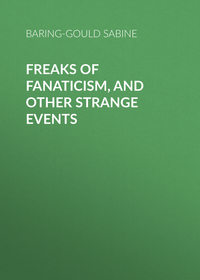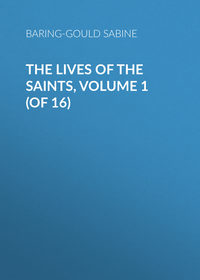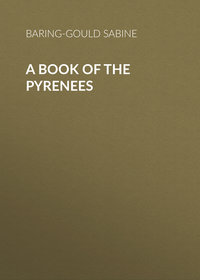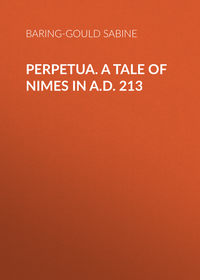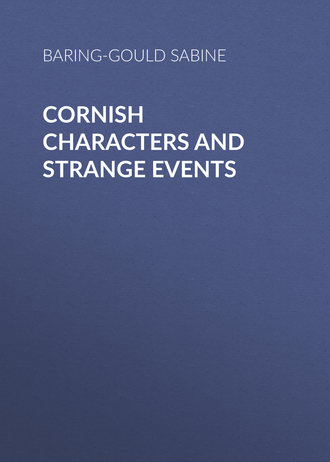 полная версия
полная версияCornish Characters and Strange Events
Portraits were taken of him by Mogford in 1851, and by Herkomer in 1888; both are in the Combination-room of St. John's College, Cambridge.
A biographical notice of him was prefixed by Professor Glaisher to his scientific works, edited by W. G. Adams, in 1896-8.
See also A. De Morgan's Budget of Paradoxes, 1872, and the Mechanics' Magazine, 1846.
DANIEL GUMB
All that is really known of this eccentric character is found in a letter of J. B. to Richard Polwhele, dated September, 1814. His correspondent says: —
"Daniel Gumb was born in the parish of Linkinhorne, in Cornwall, about the commencement of the last century, and was bred a stone-cutter. In the early part of his life he was remarkable for his love of reading and a degree of reserve even exceeding what is observable in persons of studious habits. By close application Daniel acquired, even in his youth, a considerable stock of mathematical knowledge, and, in consequence, became celebrated throughout the adjoining parishes. Called by his occupation to hew blocks of granite on the neighbouring commons, and especially in the vicinity of that great natural curiosity called the Cheesewring, he discovered near this spot an immense block, whose upper surface was an inclined plane. This, it struck him, might be made the roof of a habitation such as he desired; sufficiently secluded from the busy haunts of men to enable him to pursue his studies without interruption, whilst it was contiguous to the scene of his daily labour. Immediately Daniel went to work, and cautiously excavating the earth underneath, to nearly the extent of the stone above, he obtained a habitation which he thought sufficiently commodious. The sides he lined with stone, cemented with lime, whilst a chimney was made by perforating the earth at one side of the roof. From the elevated spot on which stood this extraordinary dwelling could be seen Dartmoor and Exmoor on the east, Hartland on the north, the sea and the port of Plymouth on the south, and S. Austell and Bodmin Hills on the west, with all the intermediate beautiful scenery. The top of the rock which roofed his house served Daniel for an observatory, where at every favourable opportunity he watched the motions of the heavenly bodies, and on the surface of which, with his chisel, he carved a variety of diagrams, illustrative of the most difficult problems of Euclid, etc. These he left behind him as evidences of the patience and ingenuity with which he surmounted the obstacles that his station in life had placed in the way of his mental improvement.
"But the choice of his house and the mode in which he pursued his studies were not his only eccentricities. His house became his chapel also; and he was never known to descend from the craggy mountain on which it stood, to attend his parish church or any other place of worship.
"Death, which alike seizes on the philosopher and the fool, at length found out the retreat of Daniel Gumb, and lodged him in a house more narrow than that which he had dug for himself."
Bond in his Topographical and Historical Sketches of the Boroughs of East and West Looe, 1873, describes the habitation of Daniel Gumb as seen by him in 1802: —
"When we reached Cheesewring – our guide first led us to the house of Daniel Gumb (a stone-cutter), cut by him out of a solid rock of granite. This artificial cavern may be about twelve feet deep and not quite so broad; the roof consists of one flat stone of many tons weight; supported by the natural rock on one side, and by pillars of small stones on the other. How Gumb formed this last support is not easily conceived. We entered with hesitation lest the covering should be our gravestone. On the right-hand side of the door is 'D. Gumb,' with a date engraved 1735 (or 3). On the upper part of the covering stone, channels are cut to carry off the rain, probably to cause it to fall into a bucket for his use; there is also engraved on it some geometrical device formed by Gumb, as the guide told us, who also said that Gumb was accounted a pretty sensible man. I have no hesitation in saying he must have been a pretty eccentric character to have fixed on this place for his habitation; but here he dwelt for several years with his wife and children, several of whom were born and died here. His calling was that of a stone-cutter, and he fixed himself on a spot where materials could be met with to employ a thousand men for a thousand years."
The Rev. Robert S. Hawker wrote an account of Daniel Gumb for All the Year Round in 1866, and this has been reprinted in Footsteps of Former Men in Cornwall.
He pretends that when he visited the Cheesewring in 183-, there still existed fragments of Daniel Gumb's "thoughts and studies still treasured up in the existing families of himself and his wife." And he gives transcripts from these, and also from what must have been a diary. But Mr. Hawker embroidered facts with so much detail drawn from his own fancy, that his statements have to be taken with a very large pinch of salt.
It must be remembered, in his justification, that his stories of Cornish Characters were intended as magazine articles to amuse, but without any purpose of having them regarded as strictly biographical and historical. They were brief historical romances, and were not intended to be taken seriously.
I will give but one quotation, and the reader can judge for himself therefrom whether it does not look like an extract "made in Morwenstow." Mr. Hawker says: —
"On the fly-leaves of an old account book the following strange statement appears: 'June 23rd, 1764. To-day, at bright noon, I looked up and saw all at once a stranger standing on the turf, just above my block. He was dressed like an old picture I remember in the windows of S. Neot's Church, in a long brown garment, with a girdle; and his head was uncovered and grizzled with long hair. He spoke to me, and he said in a low, clear voice, "Daniel, that work is hard!" I wondered that he should know my name, and I answered, "Yes, sir; but I am used to it and don't mind it, for the sake of the faces at home." Then he said, sounding his words like a psalm, "Man goeth forth to his work and to his labour until the evening. When will it be night with Daniel Gumb?" I began to feel queer; it seemed to me that there was something awful about the unknown man. I even shook. Then he said again, "Fear nothing. The happiest man in all the earth is he that wins his daily bread by his daily sweat, if he will but fear God and do man no wrong." I bent down my head like any one dumbfounded, and I greatly wondered who this strange appearance could be. He was not like a preacher, for he looked me full in the face; nor a bit like a parson, for he seemed very meek and kind. I began to think it was a spirit, only such ones always come by night, and here was I at noonday and at work. So I made up my mind to drop my hammer and step up and ask his name right out. But when I looked up he was gone, and that clear out of my sight, on the bare, wide moor, suddenly.'"
Now, in the first place, no trace or tidings of these notes so treasured up by the family are to be found in the parish of Linkinhorne, to which Gumb and his wife belonged.
In the second place, Mr. Hawker makes Daniel remark that his mysterious visitant was not like a Dissenting preacher because he looked him straight in the face, and this is significantly like a remark Hawker often made with regard to these gentry.
Another of these pretended notes refers to the finding of a fossil fish embedded in granite. This alone suffices to wake suspicion that the extracts are not genuine. Fossils never have been found in granite, and never will be. But Hawker himself did not know this, as he was totally ignorant of the first principles of geology.
LAURENCE BRADDON
Laurence Braddon, second son of Captain William Braddon, of Treworgy, in S. Gennys, was called to the bar of the Middle Temple, and worked at his profession diligently. He entered Parliament in 1651, but did not attract special notice till the occasion of the suicide of the Earl of Essex in the Tower, in 1683.
The people of England had been, and still were, greatly troubled about the succession to the throne, in the event of the death of Charles II. They had no mind to have the throne occupied by a Popish prince, and several plots were hatched to prevent such a contingency. Monmouth, with Lord Essex, Shaftesbury, Lord Howard of Escrick, Russell, Algernon Sidney, and John Hampden, held meetings to found an association to agitate and compel the King to assemble Parliament, to take measures to secure a Protestant succession and the exclusion of the Duke of York. On other points they disagreed. Monmouth hoped to have his legitimacy established and to secure the crown for his own brows. Sidney and Essex were for the establishment of a commonwealth. Russell and Hampden intended only the exclusion of the Duke. As to Lord Howard, he was a man of no principle, and his sole desire was to fish in troubled waters and get out of them what he could.
More desperate spirits schemed plans of assassination, and a plot was formed for murdering Charles and the Duke of York as they passed the Rye House on the road from London to Newmarket, but there is no evidence that the noble schemers had any knowledge of the Rye House Plot.
Both projects were betrayed, and though they were wholly distinct from one another, the cruel ingenuity of the Crown lawyers blended them into one.
The Earl of Shaftesbury fled to the Continent; Monmouth absconded; Russell was committed to the Tower; Howard, who had concealed himself in a chimney, was drawn forth by the heels, and to secure his neck betrayed Essex, Sidney, and Hampden, who were all committed to the Tower.
Several of the conspirators in the Rye House Plot were sentenced to death and at once executed. From their confessions it appeared that the conspiracy had wide ramifications, and that a scheme of insurrection throughout the country had been formed, and that steps had been taken to organize it.
On the day upon which Lord Russell was brought to trial the Earl of Essex was found in the closet of his chamber with his throat cut, and this but just after a visit to the Tower by the King with the Duke of York.
An inquest was at once held, at which it was shown that Lord Essex was a man of a despondent temper, that he had been lately in a lugubrious mood, and in the depths of melancholy; and evidence was conclusive that he had cut his own throat with a razor. The jury accordingly found a verdict of felo de se.
Now it so fell out that on the following Sunday Laurence Braddon went to visit a Mr. Evans, of the Custom House, at his country house at Wanstead, in Essex, where was also a Mr. Halstead, and Evans was telling Halstead that he had heard from a kinsman of his named Edwards, also in the Customs, that his boy had been in the Tower yard on the morning of the death of Lord Essex, and that he had seen a hand thrust out of that nobleman's window, and a razor stained with blood thrown down on the pavement of the yard. Next moment a maid-servant wearing a white hood had run out, secured the razor and carried it within, and that he had heard cries from within of "Murder! Murder!"
Braddon listened, walking up and down the room, as Evans told this story. He was greatly excited by it, and thought that it pointed to a murder having been committed, and that probably at the instigation of the Duke of York.
Accordingly Braddon went next day to the quay and got Evans and Edwards to meet him at the "Star" public-house and repeat the story. It seemed that Edwards had two boys who were in Merchant Taylors' School, and that one of their sisters was married and living in the Tower. On the morning of the death of Lord Essex the lads were on their way to school, when, passing the Tower, they heard that the King and the Duke of York were in it, whereupon the younger, an urchin of twelve or thirteen, gave his brother the slip, and ran in to see the King and the Duke. After they had departed he remained in the yard playing chuck-farthing with other boys, when he saw a hand thrust forth from a window and throw a bloody razor into the court, and after that a maid or woman in a white hood and stuff coat took it up and went in, and then he heard a noise as of "Murder!" cried out. Braddon then went to the house of Edwards to question the boy, who prevaricated. Braddon believed that the child's mother and sister had been at him, telling him that he was likely to get them all into trouble if he persisted in his tale, and urged by them, professed that he had told a lie.
The matter became common talk on the quay and the purlieus of the Tower.
Braddon had no great difficulty in finding a little girl named Jane Lodeman, aged thirteen, who was in the same tale. This is what he took down: —
"Jane Lodeman was in the Tower on Friday morning, 13th July last, and standing almost over against the late Earl of Essex's lodging window, she saw a hand cast a razor out of my lord's window, and immediately upon this she heard shrieks, and that there was a soldier by my lord's door, who cried out to those within the house that somebody should come and take up a razor which was thrown out of the window, whereupon there came a maid with a white hood out of the house, but who took up the razor she can't tell."
Dated 8th August, 1683.
On July 20th Braddon had gone to Whitehall before he had obtained this corroborative evidence, and had laid information before the King and Council, and produced a written deposition as to what the boy Edwards had said he had seen; but the boy's sister deposed that Mr. Laurence Braddon had forced her brother to sign it. Soon after Braddon had taken this step, he heard a rumour that the fact of the violent death of the Earl of Essex had been known and discussed in Frome Selwood the same day, and he hurried off to make inquiries into this. But on reaching Salisbury he was arrested, thrown into prison, and brought back to London. Another gentleman, a Mr. Speeke, had also been spreading the report that Lord Essex had been foully murdered, and it was hinted that the Duke of York, if not the King, had ordered the assassination. Speeke also was arrested.
Narcissus Luttrell's account of the death of Essex is as follows: —
1683, 13th July. – "About nine in the morning, the Earl of Essex, prisoner in the Tower of London, upon account of this new plott, did most barbarously cut his own throat from one ear to the other with a razor. What occasioned it is doubtfull: some say, the sense of his guilt; others, the shame for being accused of such a crime, when his father, the Lord Capell, died for his loyalty to the late King; however, the coroner's jury have satt on his body, and found him felo de se, tho' some stick not to say 'tis impossible he should murther himself in so barbarous a manner; and his Majesty hath been pleased to give his goods, which were forfeited by his killing himself, to his son."
On November 6th he says: "Mr. Speak was brought to the Court of King's Bench, and charged with two informations: the 1st, for saying the King was as great a Papist as the Duke of York; that the Duke durst not doe what he did but that the King did animate him; that what Pilkington had formerly said of the Duke of York was true; with much other such scandalous stuff; and 2nd was for sayeing that the Earl of Essex was killed and murdered by those that attended on him in the Tower; to both these he pleaded Not Guilty."
1683-4, February 7th. – "Mr. Lawrence Braddon and Mr. Hugh Speke were tried at the Court of King's Bench, by a jury of Middlesex, upon an information reciting the commitment of the late Earl of Essex to the Tower for treason in conspiring the death of the King, etc., and that the 13th July last he cut his own throat, and was found felo de se by the coroner's inquisition; the said Braddon and Speke did conspire by writing and otherwise, to spread a false and scandalous report, that the said Earl was murdered by some persons about him, and endeavoured to suborn witnesses to testifye the same. The evidence for the King, was first, the warder of the Tower, who testified as to his Lordship's commitment; then the coroner, and the inquisition taken before him, whereby his Lordship was found felo de se, was read; then the particular evidence against Mr. Braddon was, by severall persons, how busy and sollicitous he was to take persons' informations, and to examine a little child about ten years old, about a discourse that ran through the town that a bloody razor was thrown out of his Lordship's window; and that the cry of Murder was heard; and that a servant maid came presently out of the house of the Lord of Essex, and took up the razor, and carried it in; and that then it was said the Lord of Essex had killed himself. Then the severall informations Braddon had taken in writing relating to this matter were read, and some of the informants themselves examined, whose testimony much differ'd from their informations, then severall testified the confident and strange discourse this Braddon frequently us'd concerning the matter. The evidence against Mr. Speke was only a letter writt by him to Sir Robert Atkins th' elder, and carried by Mr. Braddon, but was seized about him when he was going thither, which contained severall expressions in commendation of Mr. Braddon and his zeale, with reflexions on this matter; then the evidence was given of his Lordship's cutting his own throat with a razor, which was proved by his own servant, a Frenchman; by the warder, by the centinell, and by Capt. Hawley. The defendants' proof was, first, Braddon pretended he did nothing but out of zeale to have the truth come out: then he call'd some witnesses to prove that there was a discourse of the Lord of Essex's being killed, and a razor thrown out, before he concern'd himself in it. Speke had little to say against the letter, but own'd it to be his hand; so that the jury, after a little while, agreed of their verdict, and found the defendant Braddon guilty of all that was laid in the information, and the defendant Speke guilty of all except the conspiring to suborn witnesses.
"'Twas strange any man should concern himself in an affair of this moment on the information of a boy ten years old, who had denied all after he had confess'd it, and did at his tryall, and make all this rent that was about it."
April 21st, 1684. – "Mr. Laurence Braddon and Mr. Hugh Speke, convicted last term upon an endeavour to lay the murder of the late Earl of Essex upon the Government, were brought to the Court of King's Bench to receive their judgments; which was, that Braddon should pay a fine of £2000, and Speke £1000 to the King; that they find sureties for their good behaviour during their lives, and be committed to the King's Bench prison till they doe so."
Hugh Speke, who was tried along with Laurence Braddon, was an inveterate plotter. Macaulay thus describes him: "Hugh Speke (was) a young man of good family, but of a singularly base and depraved nature. His love of mischief and of dark and crooked ways amounted almost to madness. To cause confusion without being found out was his business and his pastime; and he had a rare skill in using honest enthusiasts as the instruments of his cold-blooded malice."
Referring to the case of Braddon, Macaulay adds: "He had attempted, by means of one of his puppets, to fasten on Charles and James the crime of murdering Essex in the Tower. On this occasion the agency of Speke had been traced; and though he succeeded in throwing the greater part of the blame on his dupe, he had not escaped with impunity."
He was certainly a clever scoundrel, for he managed to cover up most of his traces in the affair of the charge of the murder of Essex.
Braddon was sincere, while Speke was not. Braddon was convinced that a murder had been committed, and he had not a well-balanced mind to weigh evidence. Speke cared nothing whether crime had been committed or not so long as he could disturb men's minds with a suspicion that one had been committed, and that by the King's brother and heir presumptive to the Crown.
The evidence produced by Laurence Braddon was practically worthless. He had but the word of two little children, and the boy had retracted and acknowledged that he had told lies. As to the fact of the death of Lord Essex being known at Frome on the 13th, showing that the murder had been premeditated and was part of a widely ramified scheme of the Papists, it was shown that nothing was known there of it till many days later.
The evidence for the King was Bomeny, the valet de chambre of Lord Essex. He stated that the Earl had long nails, and that morning had asked for a penknife so as to pare them. Bomeny had commissioned a footman, William Turner, to get one, and bring it along with some provisions ordered for the Earl's breakfast. Turner brought the provisions, but had forgotten about the penknife, whereupon Lord Essex began to cut his nails with his razor, and the footman was again despatched for a penknife. Just then the King and the Duke of York arrived at the Tower, and there was great bustle in the yard, and Bomeny left the Earl's room. When he met the footman with the knife he returned, but not finding Lord Essex in his chamber, he tried to open the closet door, when he found that there was an obstruction. Somewhat alarmed, he ran to Russell, the warder, whose door was almost opposite on the same staircase, and both went to the closet, and found Lord Essex lying in it with his throat cut and his feet against the door.
Russell corroborated this evidence, and added that no one could possibly ascend the stair and enter Lord Essex's chamber without his knowledge. The soldier, Lloyd, who acted as sentinel at the entrance to the Earl's quarters, testified that there was no truth in the children's tale about the razor, and that no maid had issued from the door to pick one up.
It was further established that the closet window did not look into the main yard, and was so arranged that a hand could not be passed out of it.
Judge Jeffreys conducted the investigation, and that in a most unseemly manner. Apparently he was drunk at the time, and was so confused that he was not able to follow the evidence. He browbeat the witnesses in the most offensive way.
On November 6th, 1684, a French Protestant refugee, named Borleau, was indicted for selling a scandalous book called L'Esprit de Monsieur Arnaud, in which he declared that the Earl of Essex had not cut his own throat, but had been foully murdered. He pleaded guilty, and the King graciously allowed him to be fined only 6s. 8d., and to be discharged without paying his fees. There was most certainly fish made of one and fowl of another.
Again, in December of the same year a book appeared entitled An Enquiry about the Barbarous Murder of the Earl of Essex, that was vended surreptitiously, and a broadside written by Colonel Danvers, giving the evidence that he was murdered, was thrown in at open doors and distributed in the streets of London. A hundred pounds was offered for the apprehension of Danvers. As to the book, it was from the pen of Laurence Braddon, and was later, when it could be done safely, acknowledged by him. On January 23rd, 1684-5, a Mr. Henry Baker pleaded guilty to an information for using scandalous words about the Duke of York, and at the same time a printer, Norden, did the same to an indictment for publishing the "scandalous libell in vindication of the lord of Essex." And on February 3rd one of the jury at the inquest, Launcelot Colston by name, was had up before King's Bench on a charge of having said that he did not believe that the Earl had cut his throat, for he could not have done so himself in the way in which he was found. Norden was sentenced to pay 200 marks, and to stand in the pillory at Ratcliffe, and to be bound to his good behaviour for seven years, and be committed to prison till this was done.
In 1685, on the landing of the Duke of Monmouth, in the Proclamation he published, he charged King James with the murder of Essex, with his own hand.
In January, 1689, a Captain Hawley, Major Whitley, and some two or three more were imprisoned for maintaining that Essex had not committed suicide. But this was at the moment when all power was slipping out of the hands of King James II; the Prince of Orange came to the throne, and on February 23rd a Captain Holland was arrested and thrown into prison on the charge of having been concerned in the murder of the Earl, and this was followed by numerous other arrests. But the prison-doors were thrown open for Laurence Braddon to issue forth and recommence his accusations of murder. He republished the "Enquiry into and Detection of the Barbarous Murther of the late Earl of Essex; or a Vindication of that Noble Person from the Guilt and Infamy of having Destroyed himself."



